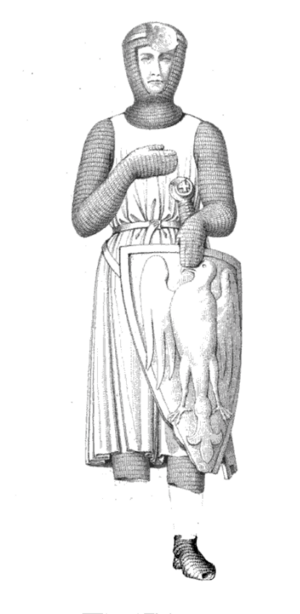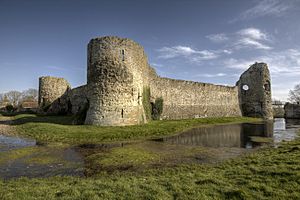Peter II, Count of Savoy facts for kids
Quick facts for kids Peter II |
|
|---|---|

Peter's funerary monument
|
|
| Count of Savoy | |
| Reign | 1263–1268 |
| Predecessor | Boniface |
| Successor | Philip I |
| Born | c. 1203 possibly Susa, Piedmont |
| Died | 15 May 1268 Château de Pierre-Châtel, Bugey |
| Burial | Hautecombe Abbey |
| Spouse | Agnes of Faucigny |
| Issue | Beatrice of Savoy, Dame of Faucigny |
| House | Savoy |
| Father | Thomas I, Count of Savoy |
| Mother | Margaret of Geneva |
Peter II (born around 1203, died May 15, 1268) was a powerful ruler known as "the Little Charlemagne." He was the Count of Savoy from 1263 until he passed away. Peter also held important lands in England, like the Honour of Richmond in Yorkshire. For a short time, he was even in charge of Dover Castle and protected the English coast. In 1243, he received land in London by the River Thames. Here, he later built the famous Savoy Palace.
Contents
Peter's Early Life and Career
Peter was born around 1203, possibly in Susa, Piedmont. He was the seventh child of Thomas I, Count of Savoy and Margaret of Geneva. His family, the House of Savoy, became very influential. This was partly thanks to his sister, Eleanor of Provence, who married King Henry III of England. His other nieces also married important kings in France, Sicily, and Germany.
Starting in the Church
As a younger son, Peter first joined the church. He held several important church jobs. From 1226 to 1233, he was a canon in Lausanne. He even served as a temporary bishop there for a short time. Peter also worked as a canon in Lyon and a provost in Aosta and Geneva. In 1234, he decided to leave his church career.
Expanding Savoy's Lands
When his father died, Peter wanted a bigger share of the family lands. He met with his older brother, Amadeus IV, Count of Savoy, in 1234. They agreed that Amadeus would be the head of the family. Peter received control of important castles like Château de Cornillon and Château d'Angeville. These castles helped him control the area around Geneva. His brother William also arranged for Peter to marry Agnes of Faucigny. This marriage gave Peter more land and helped keep him from causing trouble for his brothers.
Peter wanted even more land, which led to a fight with his uncle, William II of Geneva. In 1236, Peter was captured by his cousin, Rudolf. After this conflict ended in 1237, Amadeus forced William to sign a treaty. Geneva had to pay a large sum of money and give up the castle of Arlod. In 1240, Peter brought 6,000 troops to support his brother Philip. Philip was trying to become the Bishop of Lausanne, but the battle was not fully decided.
Peter continued to gain control of lands near Savoy. He used both money and force. In 1244, Rudolph III, Count of Gruyère, gave Gruyères Castle to Peter. Peter then gave it to Rudolph's son, William, who agreed to serve Peter's family. Peter also gained control of key towns and trade routes in the Pays de Vaud region. He often gave these lands to the younger sons of the previous rulers. Peter also made big improvements to the Château de Chillon. By 1253, he was the protector of Bern. Some historians believe that Peter's conquests helped make French the main language of western Switzerland.
Peter's Time in England
In January 1236, Peter's niece, Eleanor of Provence, married King Henry III of England. This connection brought Peter to England. On April 20, 1240, King Henry III gave Peter the Honour of Richmond. Peter was knighted on January 5, 1241. People often called him the Earl of Richmond, but he never officially held that title.
In February 1246, Peter received land in London between the Strand and the River Thames. Here, he built the Savoy Palace in 1263. This palace was later destroyed during the Peasants' Revolt in 1381. In his will, Peter left the Honour of Richmond to his niece, Queen Eleanor. She later gave it to the English crown.
Helping King Henry III
In 1241, King Henry sent Peter to gather support for a planned invasion of Poitou. Peter visited many important rulers, including his brother Amadeus IV, Count of Savoy. In February 1242, Peter went to Poitou to see if people there would support King Henry. He almost got captured but managed to escape. He then went to Provence to arrange the marriage of his niece Sanchia of Provence to King Henry's brother, Richard.
In 1246, Peter returned to Savoy to arrange a marriage deal with Amadeus. In February 1247, he came back to England with Alice of Saluzzo. She was Amadeus's granddaughter. Alice married Edmund de Lacy, Baron of Pontefract in May of that year.
Boston was an important port town on the River Witham. In 1241, Peter gained control of the manor of Boston, at the same time he received Richmond. After Peter's death, Boston was returned to John I, Duke of Brittany. Peter also gained control of Donington manor around 1255. He received permission to hold a market there every Saturday and a fair every August 15.

In 1246, the king gave Peter Pevensey Castle. Peter first supported Simon de Montfort in the Second Barons' War in 1258. However, from 1261, he sided with his niece, Queen Eleanor of Provence, and his son-in-law, King Henry III of England, against Montfort.
English Reforms and War
Peter of Savoy played a key role in the events that led to the Provisions of Oxford in England in 1258. These events would lead to the Second Barons' War. Before formal demands were made to King Henry III in April 1258, several powerful barons made an oath. They promised to help each other reform the kingdom. Peter of Savoy was one of these barons. He joined them to reduce the power of King Henry III's half-brothers, the Lusignans. Peter and his niece, Queen Eleanor, felt the Lusignans had too much influence at court. However, Peter left the reformers in 1260 when Montfort removed him from the ruling council. After this, Peter spent more and more time in Savoy until he became the Count of Savoy in 1263.
Becoming Count of Savoy
When Peter's nephew, Boniface, Count of Savoy, died in 1263 without children, there was a question about who would rule Savoy next. Besides Peter, there was another possible ruler: Peter's 15-year-old nephew, Thomas III of Piedmont. Peter returned to Savoy and was recognized as the new count over his nephew. This led to a disagreement between Savoy and Piedmont that lasted even after Peter and Thomas died.
Peter brought many new ideas back to Savoy from his travels. He started building castles with round shapes, which were different from the square castles built before. He also divided the county into smaller areas called bailis and castellanies. He set up an office in Chambéry to manage money matters better. Peter was also the first Count of Savoy to create laws for the entire county. These laws included a rule that judges should not delay justice, which was similar to the Magna Carta in England.
Peter also had a conflict with Rudolf of Habsburg. Rudolf took over Peter's lands in the canton of Vaud, including the Château of Chillon. Peter returned from Piedmont and led his troops to take back the castle and his lands in 1266.
Peter died in 1268 at the castle of Pierre-Châtel. He did not have any sons to inherit his title. He was buried in Hautecombe Abbey. In his will, he left his English lands to his niece, Eleanor of Provence, the Queen of England. However, King Henry III of England later changed some of these bequests. Peter was succeeded as Count of Savoy by his remaining brother, Philip.
Family Life
Peter married Agnes of Faucigny in 1236. They had one daughter named Beatrice. Beatrice inherited Faucigny from her mother. This territory was in the middle of Savoy's lands, but it went to the Dauphin, who were often against Savoy.
Peter also had an illegitimate daughter named Isabelle. She married her cousin, Pierre of Salinento, who was the illegitimate son of Amadeus IV, Count of Savoy.


